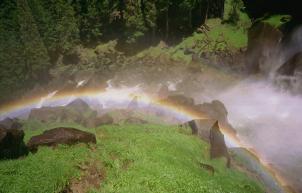Reflected Light Rainbows
Some
of us were lucky to see two rainbows on top of a lake or a pond or a
waterfall. These two rainbows are produced by sunlight from two
directions. The source of light for one rainbow was sunlight. Yet,
the source of light for the second rainbow is the reflected image of
sunlight from the water. SInce the sunlight is coming from two
directions, the elevation of the rainbows will be different. The
rainbow produced by the reflection of light will be higher than than
the rainbow produced by direct light.
Another
type of reflective rainbow can be seen on water surfaces like puddles
or ponds. After a heavy rainfall, there are lots of spherical
floating on a water surface.

Figure 5: Photo of a rainbow at Yosemite.
Source: http://redbaron.bishops.ntc.nf.ca/science/physics/papers/rainbow.htmi
Source: http://redbaron.bishops.ntc.nf.ca/science/physics/papers/rainbow.htmi
Therefore,
it ispossible for a rainbow to be formed from indirect light rays.
One of the main sources of light is from light, which is reflected
back of a water surface, such as a lake or ocean. If we look at
two raindrops, the first contributes to the rainbow formed by rays
direct from the sun, and the other drop contributes to the rainbow
formed by the indirect rays (the one which are reflected off the
water surface). The rays leaving both of the drops leave at 42
degrees to the paths at which they entered. Thus, it is clear that a
rainbow produced by a reflected light source will appear higher in
the sky than one formed by direct sunlight.